| Article ID | Journal | Published Year | Pages | File Type |
|---|---|---|---|---|
| 3117608 | American Journal of Orthodontics and Dentofacial Orthopedics | 2010 | 12 Pages |
IntroductionIn this study, we aimed to evaluate the reasons for failure of orthodontic treatment for impacted maxillary canines and to recommend measures to overcome them.MethodsTwenty-eight patients (ages, 17.4 ± 4.3 years) with 37 maxillary impacted canines were referred after a failed attempt to resolve the impaction. Reasons for failure were analyzed, and corrective measures undertaken. The success rate of the revised treatments and the durations of both treatments were recorded.ResultsThe mean duration of the failed treatments was 26.2 ± 17.2 months. The failed treatments were mostly based on plane radiographs, intra-arch dental anchorage, and elastic traction directly to the labial archwire. The major reasons for failure were inadequate anchorage (48.6%), mistaken location and directional traction (40.5%), and ankylosis (32.4%). In several patients, there was more than 1 possible reason for failure. The success rate of the revised treatments was 71.4%, and the mean duration was 14.4 ± 7.2 months. Repeat surgery was needed for 62.9% of the canines in which corrective treatment was started, mostly to redirect the ligature wires. The corrective measures included the use of 3-dimensional imaging and a change in the direction of traction. Anchorage was reinforced by dental and skeletal means.ConclusionsInaccurate 3-dimensional diagnosis of location and orientation of impacted teeth and failure to appreciate anchorage demands were the major reasons for failure in the treatment of impacted canines.
